Table of contents
- Motorcycle production, part 1: Honda How are motorcycles produced?
- Honda success story
- Three pillars of Honda
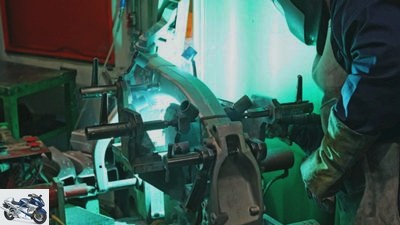
Jahn
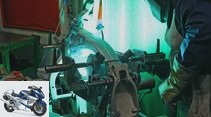
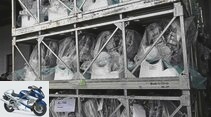
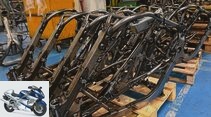
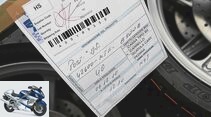
15th pictures
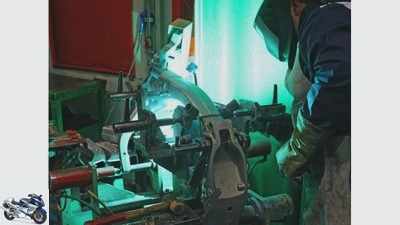
Jahn
1/15
How are motorcycles produced? Where do the parts come from, what happens before final assembly? These questions urged MOTORRAD to take a closer look at motorcycle production. In a series with various producers, Honda begins its factory in Atessa, Italy.
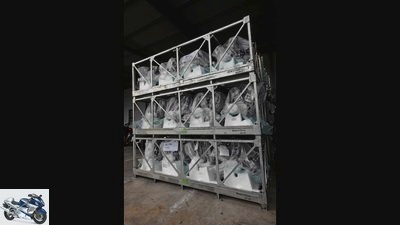
Jahn
2/15
1. Transalp engines from Japan: only the transport racks are “Made in China”.
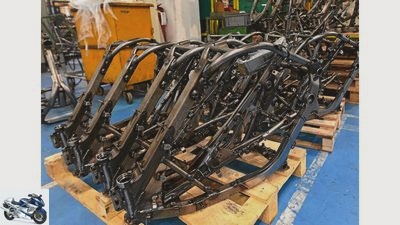
Jahn
3/15
2. Transalp frame from Spain: three sections were interlocked for transport; they are completely welded in Atessa and then painted.
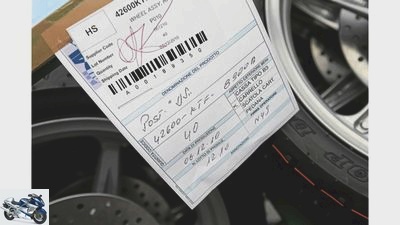
Jahn
4/15
3. Wheels with tires and brake discs from Northern Italy: they must be processed within two days, otherwise they will cost storage tax.
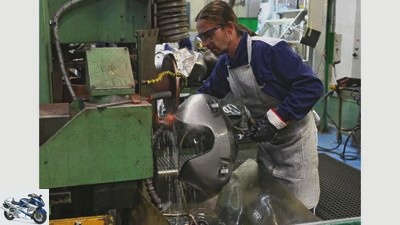
Jahn
5/15
4. The man at the roll welder has to execute a complicated choreography with the greatest possible precision.
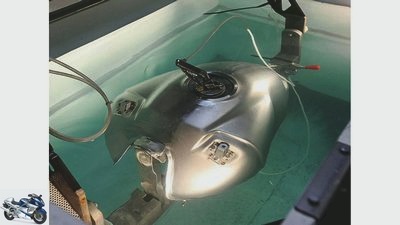
Jahn
6/15
5. After welding and grinding the central seam, the tank is checked for leaks at a pressure of eight bar.
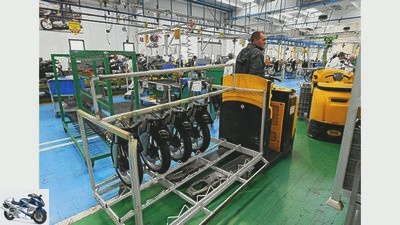
Jahn
7/15
6. A squadron of drivers on electric forklifts, also known as ants, is responsible for feeding the parts and assemblies to the conveyor belt.
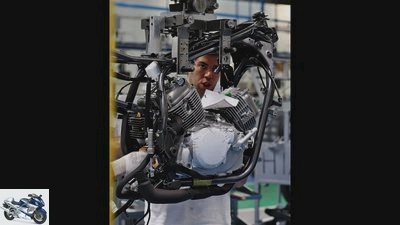
Jahn
8/15
7. Motor and frame are connected and are completed hanging for better accessibility.
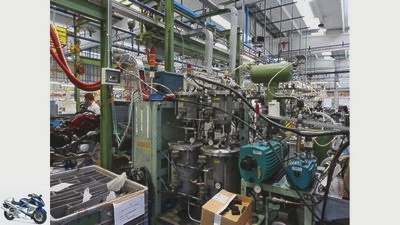
Jahn
9/15
8.1 This collection of pumps and pressure vessels fills and vents the cooling circuit and braking system.
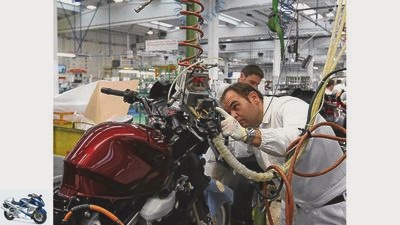
Jahn
10/15
8.2 Start, it hisses and slurps, and the horsefly has its liquid.
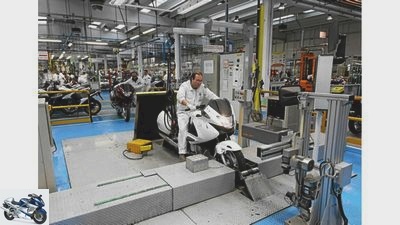
Jahn
11/15
9. Every Honda makes its first ride on the test bench, including checking the headlight setting.
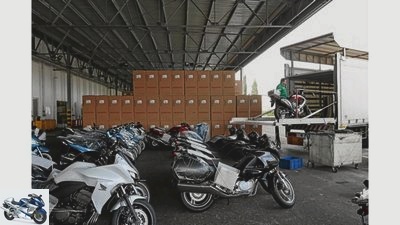
Jahn
12/15
10. Only items that have to travel abroad are allowed in the box. In order to save transport space, tall cladding panels are included, not installed.

Honda
13/15
One of two production facilities for large-volume Hondas: the Atessa plant.
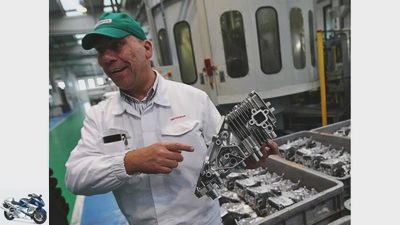
Jahn
14/15
All drilling at once: inspector Fiorentino is proud of the automated engine construction.
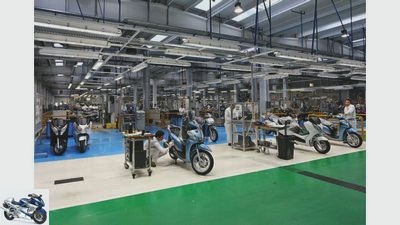
Jahn
15/15
During the crisis, scooter production was a reliable source of revenue.
counselor
workshop
Motorcycle production, part 1: Honda
Motorcycle production, part 1: Honda
How are motorcycles produced?
How are motorcycles produced? Where do the parts come from, what happens before final assembly? MOTORRAD looked around at three manufacturers. This report about the Italian Honda plant in Atessa marks the beginning of a series.
Ralf Schneider
02/03/2011
A Honda from Atessa consists of around 1200 larger parts. If you count every screw, washer and nut, there are even around 4,000 parts. Motorcycle production therefore means bringing 160 by 4000 parts, individually or pre-assembled, to the right place at the same time, where they are put together by competent workers. Around 250 working days a year.
This is based on the rather low production figures in 2010, when 40,000 motorcycles were built in Atessa. Not to forget the 70,000 scooters and 342,000 motors for lawnmowers, generators and pumps that were built there in the same period. In the years 2004 to 2008, motorcycle production was just below the 50,000 threshold, and scooters reached 70,000 to 120,000 units per year during this period. And on engines for so-called “power products” the central Italian plant has already created over 700,000 pieces annually.
Buy complete article
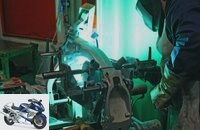
Motorcycle production, part 1: Honda
How are motorcycles produced?
6 pages) as PDF
€ 2.00
Buy now
The large part of the stream that is compressed into motorcycles in Atessa is fed by four tributaries. One comes from the immediate vicinity in the valley of the Sangro. A consortium of supplier companies has settled there since the plant was set up in the 1970s and has come together under the leadership of Honda. Foundries, electroplating shops, companies that manufacture plastic parts using the injection molding process, press sheet metal parts, produce axles or fittings on CNC machining centers or weave cable harnesses. Twice a day, at eight and at 2 p.m., they deliver their products, which are processed immediately – just in time.
The second part inflow takes a little further way. The Honda plant purchases components, indeed entire assemblies such as forks and wheels, from companies in Turin and Milan, which have been built in the vicinity of Fiat and the northern Italian motorcycle manufacturers since the 1930s. According to Italian legislation, ready-to-install material is considered to be in stock after two days of idle time and must be taxed; the bikes in picture number three, delivered on December 6th and photographed by MOTORRAD photographer Markus Jahn on the 7th, had to be installed on the same day as the following day was a public holiday in Italy.
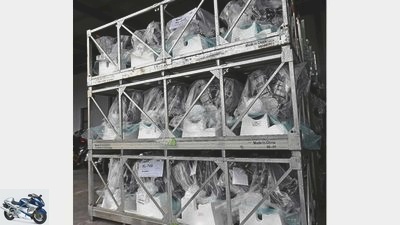
Jahn
Transalp engines from Japan: only the transport racks are “Made in china”.
The third influx has the longest way, it comes two weeks in advance by ship from the Honda plant in Kumamoto on the Japanese south island of Kyushu. It concerns all engines with more than 125 cm³ displacement, the 680-V2 from Deauville (cardan drive) and Transalp (chain drive), the 996-V2 from Varadero and the four-cylinder in-line engines with 599 and 998 cm³ displacement, which are in different versions drive the CB and CBF models and, more recently, the CBR 600 F (photo show image 1.). The V2 of the Varadero 125 is assembled in Atessa, but the parts also come from Japan.
The two Varadero, like the Transalp and the Deauville, have a special position. Their production was relocated to Italy from Honda’s own Montesa plant near Barcelona in April 2010. This also leads to a special form of parts delivery, because the steel frames of the Transalp are still being manufactured by Montesa in Spain. When you come to Atessa, the time-consuming welds on small sheet metal holders or threaded bushings have already been carried out, but due to the smaller transport dimensions and the warehousing law, three frame sections are welded and painted in the Italian factory.
The fourth inflow is the parts produced there. The most important of these are the tanks and the aluminum backbone frames, which are identical in construction but with different engine mounts and paintwork in all four-cylinder models. After painting or powder coating, drying, leak testing and pre-assembly of petrol pumps or small parts, they are transported in large goods carriers by forklift to the confluence of the flows, the production line.
Here all motorcycle models are screwed together in lots of 60 units or a multiple thereof. Special equipment such as ABS can be installed from one batch to another; other permanently installed accessories are not intended as individual equipment. The scooter models are mounted on the second, parallel belt at a higher cycle rate. There is a pragmatic coexistence of manual work and modern technology, but industrial robots, which hold half-finished sheet metal containers to a series of belt grinding machines with jagged, sweeping movements during tank production, are not used here. Two fitters, like almost all colleagues up to the plant director, put the double loop frame of a Varadero 125 over an engine on the right-hand side, turn it like a bayonet lock until the mounting points on the frame and engine are aligned and the inserted engine retaining bolts fall into position . Inexperienced users would have caused a lot of paint damage on the frame. Then the tubular frame is erected, the nuts are put on and tightened with compressed air torque wrenches. From the inside to the outside, first in inaccessible places later, the assemblies come together, a few stations further the conveyor belt that runs at table height ends, the shell is hung up and is ready to accommodate parts that extend further, such as the rocker arm, spring elements and wheels.
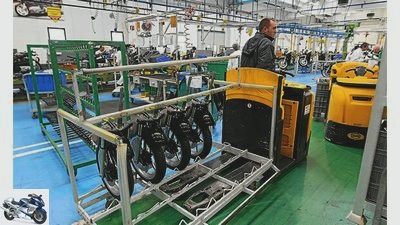
Jahn
A squadron of drivers on electric forklifts, also known as ants, is responsible for feeding the parts and assemblies to the conveyor belt.
Further ahead, the last Deauville of the previous production batch receive coolant and brake fluid from a single machine. The cooling circuit and brake hydraulics are filled and vented within a minute; Anyone who has done this themselves can assess the time and money savings that the expensive custom-made product brings with it.
After assembly, each motorcycle is put on a roller dynamometer, the engine is started, the gears are shifted, the brakes, lights and all displays are checked. This takes 75 seconds, while a motorcycle rolls off the assembly line every minute. The test bench is the bottleneck; it is calculated whether it is worth setting up a second one. “Given the current production figures, this decision still has time”, says Luca Fiorentino, coordinator of the “Quality Division”, one of the top quality controllers.
Between the test stand and the loading station, where the long-distance motorcycles are packed in cardboard boxes, which are delivered within Italy, are lashed between foam mats and blankets in the truck, everything is full of freshly produced machines. “Just a change in color turns a motorcycle into a new model for us, the first series of which is carefully checked by a group of five high-ranking inspectors”, explains Fiorentino, “we cannot deliver beforehand.” Then he leads the MOTORRAD delegation to an isolated building, prohibits photography and shows a number of measuring stations, engine, chassis and load test stands.
They partly serve to test prototypes, partly to control the current series. One motorcycle from each lot, i.e. every sixtieth, is statically measured, then the noise and pollutant emissions are checked and at the end there is a driving test.
In addition, Fiorentino and his team develop and test new manufacturing processes, for example the adhesive strength of a paintwork, and prepare the homologation of new developments.
He does not answer the question of how many motorcycles need to be repaired under warranty. This quota is secret. But when the editor talks about another motorcycle manufacturer that not only tolerates four percent, but plans it firmly because any further improvement would be disproportionately expensive, he involuntarily slips away the question: “So much?” Obviously one has other standards here.
Honda success story
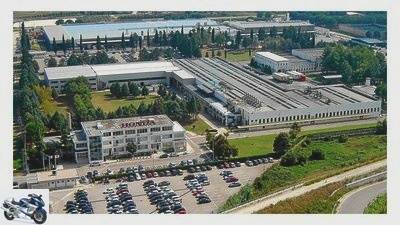
Honda
One of two production facilities for large-volume Hondas: the Atessa plant.
In 1971 as I.A.P. industriale, the plant was completely taken over by Honda in 1981 after being involved in a subsidy fraud. Since then, the site has developed into a functioning unit and a diverse supply industry has emerged in its surroundings in the valley of the Sangro River. Today, the Atessa plant is the only Honda production facility, alongside the Kumamoto plant that went into operation in 2008, in which motorcycles with a displacement of more than 300 cc are produced. One plant in the USA was closed, at Honda-Montesa in Spain only trial motorcycles and supplier parts are manufactured. In Atessa, around 700 workers work in single shifts to produce nine motorcycle and five scooter models as well as two different aggregate motors, each with two cubic capacities, in a hall area of 44,701 m². Depending on the product, the plant creates between 10 and 50 percent of the added value; sales in the 2009 financial year amounted to 568.28 million euros. About 63 percent of the production is sold in Italy.
Three pillars of Honda
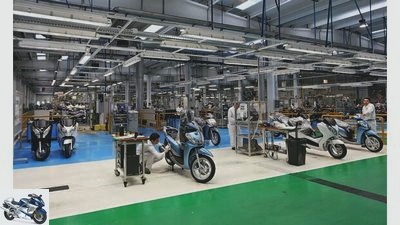
Jahn
During the crisis, scooter production was a reliable source of revenue.
They seem to have little to do with motorcycle production and yet they are a stabilizing source of revenue for the Italian plant: the scooters and the aggregate engines, most of which are made in the plant itself. By producing engines, the plant can compensate for the seasonality in the motorcycle business; the scooters, along with state subsidies, were even one of the main reasons for the plant to be located in the Sangro Valley. The proximity to Rome, Naples and other major southern Italian cities, where they are still popular, should save transport costs. And while the production of motorcycles and engines has declined by more than half since 2008, scooter production has had to be cut back significantly less.
Related articles
-
Spotlight on motorcycle production, part 3: BMW
Bilski 13th pictures Bilski 1/13 A location with tradition – the oldest halls of the Spandau plant have been in existence since 1928, and since 1939 it…
-
Motorcycle production at Bimota
Jahn counselor traffic & business Motorcycle production at Bimota This is how one of the smallest manufacturers in the world produces Motorcycle…
-
Honda NC 700 S in the test: the entry-level motorcycle from Honda
Artist 12th pictures Honda 1/12 Honda NC 700 S – The naked bike is powered by an in-line two-cylinder engine of 670 cubic meters. Honda 2/12 Honda NC 700…
-
The small ABC of motorcycle types, part 1 A ?? D.
Buell motorcycles The small ABC of motorcycle types, part 1 A ?? D. The small ABC of motorcycle types, part 1 A ?? D. ETV 1000 XB9R S4R Manufacturers…
-
10 years of progress in motorcycle series production
Rossen Gargolov 36 pictures r-photography.info 1/36 r-photography.info 2/36 In a mirror of the times: the BMW R 1200 GS, old on the left and new on the…
-
The small ABC of motorcycle types, part 3 K ?? Y
Yamaha motorcycles The small ABC of motorcycle types, part 3 K ?? Y The small ABC of motorcycle types, part 3 K ?? Y No X in front of a U Why are Z, X…
-
Motorcycle production country Thailand: Ducatis now also from Thailand?
Ducati counselor traffic & business Motorcycle production country Thailand: Ducatis now also from Thailand? Thailand is the number 5 motorcycle…
-
Honda Forza 750 test: more motorcycle than scooter
Jorg Kunstle 17th pictures Jorg Kunstle 1/17 Honda has repositioned itself with the Forza 750 among the big scooters. Jorg Kunstle 2/17 Basically you sit…
-
MOTORCYCLE comparison test Alpen-Masters 2014 part 2
jkuenstle.de 116 pictures fact, jkuenstle.de 1/116 The extreme seating position was also not ideal for the test track. fact, jkuenstle.de 2/116 However,…
-
Motorcycle tour Panamericana part 1
Army car 27 pictures Army car 1/27 A MOTORRAD volunteer fulfills a lifelong dream: from Alaska to California on a motorcycle. Army car 2/27 Pure nature:…